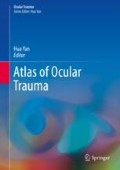Abstract
Orbital injury includes orbital soft tissue contusion, orbital fracture, orbital foreign bodies, etc. This chapter mainly discusses the injury of soft tissue and the orbital wall behind the orbital septum. The early reactions of orbital trauma were hemorrhage, exudation, and edema, and the late pathological changes were scar adhesion and fat atrophy. Mild orbital injury, such as orbital soft tissue contusion, generally does not need surgical treatment, but more serious orbital injury, such as orbital fracture which causes obvious eye sag, strabismus, etc., needs surgical treatment. This chapter report includes six cases of orbital injury, to provide a guide about diagnosis and management of orbital injury.
Access this chapter
Tax calculation will be finalised at checkout
Purchases are for personal use only
References
Lihua Xiao, Yi Wang. Diagnosis and treatment of orbital fractures. People’s Health Press; 2014.
Xiao L. Modern diagnosis of the orbital diseases, vol. 4. Beijing: Beijing Science and Technology Press; 2006.
Day KM, Phillips PM, Sargent LA. Correction of a posttraumatic orbital deformity using three-dimensional modeling, virtual surgical planning with computer-assisted design, and three-dimensional printing of custom implants. Craniomaxillofac Trauma Reconstr. 2018;11(1):78.
Nilsson J, et al. Comparison analysis of orbital shape and volume in unilateral fractured orbits. J Craniomaxillofac Surg. 2018;46:381–7.
Colletti G, et al. Endoscopic endonasal repair with polyethylene implants in medial orbital wall fractures: a prospective study on 25 cases. J Craniomaxillofac Surg. 2018;46:274–82.
Carrere JM, Lewis KT. Complete inferior rectus muscle transection secondary to orbital blowout fracture. Orbit. 2018:1–3.
Huempfnerhierl H, et al. Morphologic comparison of preformed orbital meshes. J Oral Maxillofac Surg. 2015;73(6):1119.
Scolozzi P. Reconstruction of severe medial orbital wall fractures using titanium mesh plates placed using transcaruncular-transconjunctival approach: a successful combination of 2 techniques. J Oral Maxillofac Surg. 2011;69(5):1415–20.
Scolozzi P, Momjian A, Heuberger J. Computer-aided volumetric comparison of reconstructed orbits for blow-out fractures with nonpreformed versus 3-dimensionally preformed titanium mesh plates: a preliminary study. J Comput Assist Tomogr. 2010;34(1):98–104.
Bruneau S, Scolozzi P. Preseptal transconjunctival approach to the orbital floor fractures. Surgical technique. Rev Stomatol Chir Maxillofac Chir Orale. 2015;116(6):362–7.
Ozer MA, et al. Redesign and treatment planning orbital floor reconstruction using computer analysis anatomical landmarks. Eur Arch Otorhinolaryngol. 2016;273(8):2185–91.
El-Anwar MW, Sweed AH. Infraorbital foramen localization in orbitozygomatic fractures: a CT study with intraoperative finding. Eur Arch Otorhinolaryngol. 2018;275(9):1–5.
Takahashi Y, et al. Incarceration of the inferior oblique muscle branch of the oculomotor nerve in patients with orbital floor trapdoor fracture. Graefes Arch Clin Exp Ophthalmol. 2017;255(10):2059–65.
Yang JW, Woo JE, An JH. Surgical outcomes of orbital trapdoor fracture in children and adolescents. J Cranio-Maxillofac Surg. 2015;43(4):444–7.
Neinstein RM, Phillips JH, Forrest CR. Pediatric orbital floor trapdoor fractures: outcomes and CT-based morphologic assessment of the inferior rectus muscle. J Plast Reconstr Aesthet Surg. 2012;65(7):869–74.
Kim J, et al. Endoscope-assisted repair of pediatric trapdoor fractures of the orbital floor: characterization and management. J Craniofac Surg. 2010;21(1):101.
Gerber B, Kiwanuka P, Dhariwal D. Orbital fractures in children: a review of outcomes. Br J Oral Maxillofac Surg. 2013;51(8):789.
Author information
Authors and Affiliations
Editor information
Editors and Affiliations
Rights and permissions
Copyright information
© 2019 Springer Nature Singapore Pte Ltd.
About this chapter
Cite this chapter
Li, Y., Tao, H., Zhou, X. (2019). Orbital Injury. In: Yan, H. (eds) Atlas of Ocular Trauma. Ocular Trauma. Springer, Singapore. https://doi.org/10.1007/978-981-13-1450-6_10
Download citation
DOI: https://doi.org/10.1007/978-981-13-1450-6_10
Published:
Publisher Name: Springer, Singapore
Print ISBN: 978-981-13-1449-0
Online ISBN: 978-981-13-1450-6
eBook Packages: MedicineMedicine (R0)

